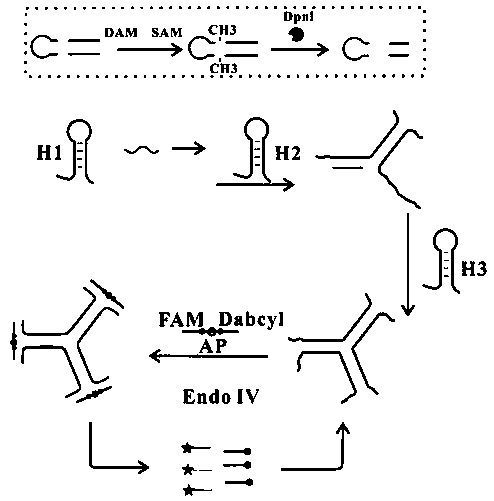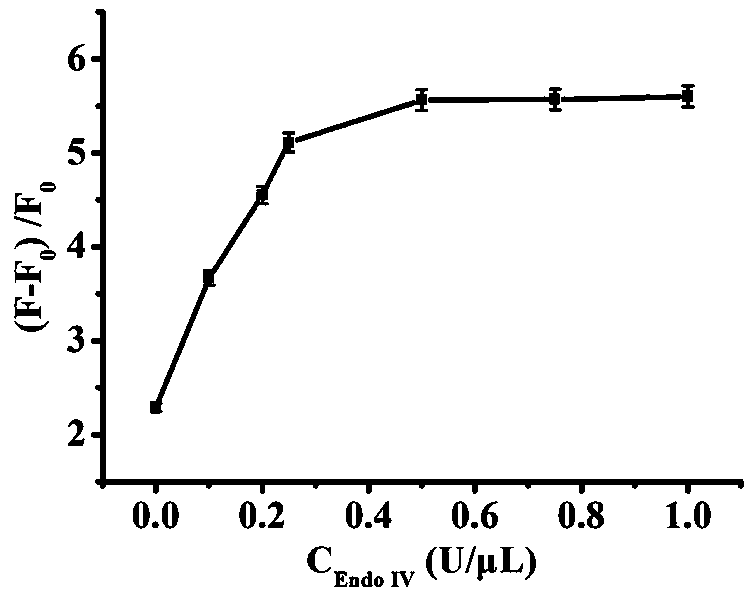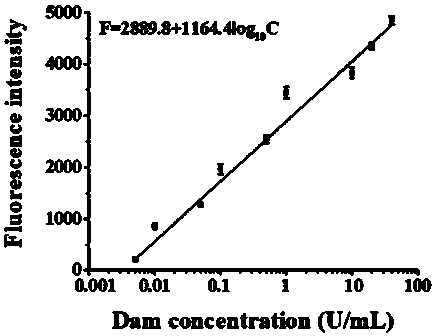Fluorescent biosensor for detecting activity of DNA transmethylase and preparation method of fluorescent biosensor
A biosensor and methyltransferase technology, applied in the field of biosensors, can solve the problems of long detection period, low specificity and sensitivity, and achieve the effects of fast detection speed, simple operation and high specificity
- Summary
- Abstract
- Description
- Claims
- Application Information
AI Technical Summary
Problems solved by technology
Method used
Image
Examples
Embodiment 1
[0051] Embodiment 1 Fluorescence intensity changes with endonuclease IV concentration
[0052] The preparation method of described fluorescent biosensor comprises the following steps:
[0053] a. Add sterilized water, 1× Dam buffer (buffer), 0.5 μM MTase chain, 160 μM SAM, and 10 U of Dam to the pre-prepared sterilized EP tube. Incubate at 37°C for 60 min.
[0054] b. Add the target substance (5 μL) that has been reacted in a to the EP tube, add 1 μL Dpnl (20 U / μL), 1×cutsmart reaction buffer 2 μL, H1 H2 H3 1 μM each, Signal probe 5 μM, 1 μL nucleic acid Dicer IV (concentrations are 0.1U / μL, 0.2U / μL, 0.3U / μL, 0.5U / μL, 0.8U / μL, 1.0 U / μL), incubate at 37°C for 90min;
[0055] c. Dilute the solution (10 μL) after the reaction in step b to 70 μL, and detect the fluorescence at 518 nm with a fluorometer.
[0056] The excitation wavelength of the fluorescence instrument is set to 486nm, the emission wavelength is 518nm, the detection range is 450nm-530nm, and the change of the fl...
Embodiment 2
[0061] Example 2 Variation of Fluorescence Intensity with Target Concentration
[0062] A preparation method of the fluorescent biosensor of the present invention:
[0063] The preparation method of described fluorescent biosensor comprises the following steps:
[0064] a. Add sterilized water, 1× Dam buffer (buffer), 0.5μM MTase chain and 160μM SAM, Dam (0.005to 40 U / mL) into the pre-prepared sterilized EP tube. Incubate at 37°C for 60 min.
[0065] b. Add the target substance (5 μL) that has been reacted in a to the EP tube, add 1 μL Pnl (20 U / μL), 1×cutsmart reaction buffer 2 μL, H1 H2 H3 each 1 μM, Signal probe 5 μM, 0.5 U / μL Incubate with endonuclease IV in an incubator at 37°C for 90 minutes;
[0066] c. Dilute the solution (10 μL) after the reaction in step b to 70 μL, and detect the fluorescence at 518 nm with a fluorometer.
[0067] The excitation wavelength of the fluorescence instrument is set to 486nm, the emission wavelength is 518nm, the detection range is 45...
Embodiment 3
[0072] Example 3 Fluorescence Intensity Changes with H1 H2 H3 Chain Concentration
[0073] The preparation method of described fluorescent biosensor comprises the following steps:
[0074] a. Add sterilized water, 1× Dam buffer (buffer), 0.5 μM MTase chain, 160 μM SAM, and 10 U of Dam to the pre-prepared sterilized EP tube. Incubate at 37°C for 60 min.
[0075] b. Add the target substance (5 μL) after the reaction in a to the EP tube, add 1 μL Pnl (20 U / μL), 2 μL of 1×cutsmart reaction buffer, H1 H2 H3 (concentrations are 10 μM, 1 μM, 0.5 μM, 0.1 μM, 0.01μM), Signalprobe take 5μM, 0.5U / μL acid endonuclease IV, incubate at 37℃ for 90min;
[0076] c. Dilute the solution (10 μL) after the reaction in step b to 70 μL, and detect the fluorescence at 518 nm with a fluorometer.
[0077] The excitation wavelength of the fluorescence instrument is set to 486nm, the emission wavelength is 518nm, the detection range is 450nm-530nm, and the change of the fluorescence signal is read to ...
PUM
 Login to View More
Login to View More Abstract
Description
Claims
Application Information
 Login to View More
Login to View More - R&D
- Intellectual Property
- Life Sciences
- Materials
- Tech Scout
- Unparalleled Data Quality
- Higher Quality Content
- 60% Fewer Hallucinations
Browse by: Latest US Patents, China's latest patents, Technical Efficacy Thesaurus, Application Domain, Technology Topic, Popular Technical Reports.
© 2025 PatSnap. All rights reserved.Legal|Privacy policy|Modern Slavery Act Transparency Statement|Sitemap|About US| Contact US: help@patsnap.com



